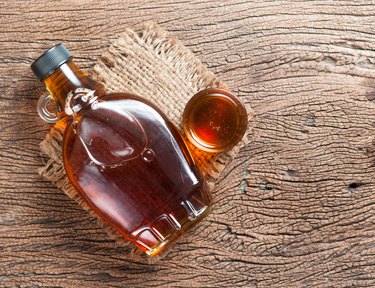
Pure maple syrup is made when the sap from sugar maple trees is collected, boiled and strained until thick enough to pour on a plate of pancakes. In addition to its unique flavor, maple syrup's nutrition benefits are surprisingly high — it contains a variety of essential vitamins and minerals.
Tip
Pure maple syrup, while still considered a sugar, contains valuable nutrients such as calcium, potassium, manganese, magnesium, phosphorus, zinc, and iron and B vitamins, among others. In small amounts, it can also be a good substitute for white sugar.
Video of the Day
Maple Syrup Uses
Maple syrup has long been a staple on the North American continent. Native Americans processed sugar maple sap and used it to make maple candies, maple drinks and other foodstuffs. According to the Harvard Museum of Natural History, European settlers were the first to boil sugar maple sap, but both Native Americans and settlers were using the process by the eighteenth century.
Video of the Day
It takes 10 gallons of boiled-down maple sap to make one quart of pure maple syrup. Maple sugaring season occurs when the sap flows — this happens when daytime temperatures rise above freezing, and nighttime temperatures fall below freezing, usually between mid-February and mid-April, depending on location. A single tree can produce about 20 gallons of sap in the short season, which can run for four to six weeks.
Pure maple syrup sold in stores is identified by grade — going from light to dark: Fancy, Grade A Medium Amber, Grade A Dark Amber and Grade B — and has many culinary uses. It can be swirled into oatmeal, drizzled over waffles, used to replace white sugar in baking, or incorporated into a marinade for meat or fish.
Maple Syrup Health Benefits
Pure maple syrup's benefits go beyond being a delicious addition to your breakfast table. It is rich in minerals such as calcium, potassium, manganese, magnesium, phosphorus, zinc and iron, the USDA Natural Resources Conservation Service reports. It also contains vitamins B2, B5, B6, niacin, biotin and folic acid, as well as trace amounts of amino acids.
An April 2015 article published in the journal Oncology Reports reveals that maple syrup is full of sucrose and glucose, as well as other components such as oligosaccharides and organic acids. Pure maple syrup may also contain various phenolic compounds such as lignans and coumarin, quebecol and ginnalin, which could have the ability to lower blood glucose levels, as well as exhibiting an anticancer effect.
In order to take advantage of pure maple syrup's beneficial qualities, when you purchase maple syrup, look at the ingredients label — it should read "pure maple syrup" or "maple syrup." If there are any more ingredients, the product will not be pure maple syrup and may have sugars added.
Read More: What are Refined Sugars?
Maple Syrup Side Effects
While maple syrup can often be substituted for cane sugar in recipes — it's sweet enough to allow you to reduce the amount of sugar while still creating a sweet result — it's important to remember, as the Cleveland Clinic points out, that studies of maple syrup extracts don't consider the impact of maple syrup on insulin and blood sugar.
In general, too much sugar in any form is bad for your health, as Harvard Men's Health Watch observes. But given maple syrup's high vitamin and mineral content, when used in small amounts, it may be a good substitute for white sugar.
In June 2019, the Food and Drug Administration issued guidance concerning sugars such as pure maple syrup and honey, stating that single-ingredient sugar products are not required to declare the number of grams of added sugars in a serving of the product on the Nutrition Facts label. However, they must still include the percent Daily Value for added sugars.
Read More: Cut Refined Sugar: Here's How to Get Started
- Cleveland Clinic: "Is Maple Syrup Better for You Than Sugar?"
- Oncology Reports: "Inhibitory Effect of Maple Syrup on the Cell Growth and Invasion of Human Colorectal Cancer Cells"
- Harvard Men's Health Watch: "The Sweet Danger of Sugar"
- Harvard University Museum of Natural History: "Sugar Maple"
- Indiana Department of Natural Resources: "Tasty Maple Syrup Starts with a Sugar Maple Tree"
- The University of Maine Extension: "Bulletin #7036, How to Tap Maple Trees and Make Maple Syrup"
- University of Vermont: "History of Maple"
- USDA: "FDA Issues Final Guidance Regarding the Declaration of Added Sugars on the Nutrition Facts Label for Honey, Maple Syrup, Other Single Ingredient Sugars and Certain Cranberry Products"
- USDA Natural Resources Conservation Service: "Maple Syrup"
- Michigan State University Extension: "Celebrating the History of Maple Syrup"
- USDA: "Agricultural Marketing Service"